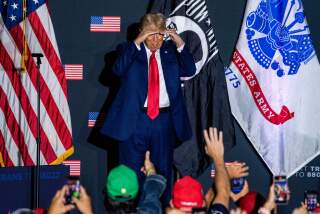A bigger TARP
New Treasury Secretary Timothy F. Geithner rolled out his first initiative Tuesday, and it was a doozy. Geithner proposed to double down on the much-maligned $700-billion Troubled Asset Relief Program, injecting up to $2 trillion in public and private money into the beleaguered financial system. The plan he offered would address some of the biggest weaknesses of the previous effort, bringing long-overdue transparency to the government’s attempts to bolster banks and targeting more factors in the credit crunch. Still, with too few details about how the new program would create a market for banks’ distressed assets and avert more foreclosures, we remain wary of its risks and effectiveness.
Having said that, we welcome much of the thinking behind this ambitious plan. It’s comprehensive, tackling not just the balance-sheet problems that are weakening banks but the rise in mortgage defaults, the credit shortages in various markets and the public’s disenchantment with the rescue efforts. It tries to bring private dollars into the mix, instead of relying solely on taxpayer funding. And it has all four federal agencies that regulate financial institutions working from a common script as they evaluate the condition of banks, thrifts and other lenders. In contrast to the Bush administration’s scattershot approach to the problem, this effort seems like a sustained barrage.
The most encouraging element of the plan is the emphasis on disclosure. Banks would be required to reveal more about their risky holdings. Federal regulators would subject larger banks to a “stress test” aimed at measuring their ability to withstand an even deeper downturn than economists expect. Those that proved relatively healthy would get capital infusions to make new loans, then would be required to issue monthly reports detailing what they did with the money. The goal here is to loosen credit markets by identifying healthy banks and to restore the public’s faith in the rescue by documenting its results.
Those efforts, combined with $1 trillion in loans from the Federal Reserve to restart crucial secondary markets in car loans, small-business lending and other sources of credit, could do much to help markets that are already starting to unfreeze. Yet Wall Street’s reaction Tuesday -- the Dow dropped 382 points -- showed that the missing elements of the plan may be even more important. How will the government persuade private investors to start buying the toxic mortgage-backed securities that are polluting so many banks’ books? How will the plan’s $50-billion program to deter foreclosures work, and what makes its chances for success any better than the government’s previous initiatives? There’s much to like about Geithner’s opening bid, but we need to see the rest of his hand.
More to Read
Inside the business of entertainment
The Wide Shot brings you news, analysis and insights on everything from streaming wars to production — and what it all means for the future.
You may occasionally receive promotional content from the Los Angeles Times.










